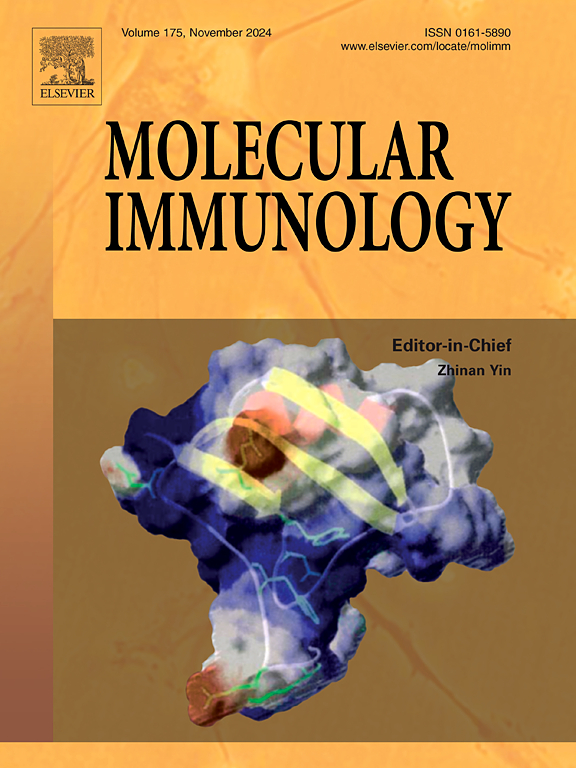Formononetin ameliorates allergic asthma by inhibiting JUN and suppressing type Ⅱ immune responses mediated by ILC2 cells
IF 3
3区 医学
Q2 BIOCHEMISTRY & MOLECULAR BIOLOGY
引用次数: 0
Abstract
Objective
Formononetin (FM), a flavonoid with potent anti-inflammatory effect, was investigated for its therapeutic potential and underlying mechanisms in allergic asthma (AS).
Methods
An ovalbumin (OVA)-induced murine model of AS was established and treated with FM. Inflammatory responses, mucus secretion, and the activation and migration of type II innate lymphoid cells (ILC2s) were assessed using histological staining, ELISA, flow cytometry, and molecular analysis. The role of the JUN gene was further explored using the JUN agonist 15(S)-HpETE. In vitro assays were conducted to evaluate FM’s effects on ILC2 proliferation and cytokine expression.
Results
FM significantly alleviated airway inflammation, reduced mucus hypersecretion, and lowered serum IgE levels. It decreased the abundance and activation of ILC2s in lung tissues and suppressed the expression of related cytokines and transcription factors. Notably, FM inhibited the lung-gut axis migration of ILC2s by reducing iILC2 and nILC2 levels in the small intestine and iILC2 levels in the lung. In vitro, FM suppressed ILC2 proliferation and activation. These effects were reversed by 15(S)-HpETE, suggesting a JUN-dependent mechanism.
Conclusions
FM ameliorates AS by inhibiting type II immune responses and ILC2 migration via targeting JUN. These findings suggest FM as a promising candidate for asthma therapy.
刺芒柄花素通过抑制JUN和ILC2细胞介导的Ⅱ型免疫反应改善过敏性哮喘
目的探讨芒柄花素(FM)作为一种具有抗炎作用的类黄酮对过敏性哮喘(AS)的治疗作用及其机制。方法建立卵清蛋白(OVA)诱导的小鼠AS模型,并用FM治疗。通过组织学染色、ELISA、流式细胞术和分子分析评估炎症反应、粘液分泌、II型先天淋巴样细胞(ILC2s)的激活和迁移。使用JUN激动剂15(S)-HpETE进一步探索JUN基因的作用。体外实验评估了FM对ILC2增殖和细胞因子表达的影响。结果fm能明显减轻气道炎症反应,减少黏液分泌,降低血清IgE水平。降低肺组织中ILC2s的丰度和活性,抑制相关细胞因子和转录因子的表达。值得注意的是,FM通过降低小肠中的iILC2和nILC2水平以及肺中的iILC2水平来抑制ILC2s的肺肠轴迁移。在体外,FM抑制ILC2的增殖和激活。这些效应被15(S)-HpETE逆转,提示jun依赖性机制。结论FM通过靶向jun抑制II型免疫应答和ILC2迁移,从而改善AS,提示FM是一种有前景的哮喘治疗候选药物。
本文章由计算机程序翻译,如有差异,请以英文原文为准。
求助全文
约1分钟内获得全文
求助全文
来源期刊

Molecular immunology
医学-免疫学
CiteScore
6.90
自引率
2.80%
发文量
324
审稿时长
50 days
期刊介绍:
Molecular Immunology publishes original articles, reviews and commentaries on all areas of immunology, with a particular focus on description of cellular, biochemical or genetic mechanisms underlying immunological phenomena. Studies on all model organisms, from invertebrates to humans, are suitable. Examples include, but are not restricted to:
Infection, autoimmunity, transplantation, immunodeficiencies, inflammation and tumor immunology
Mechanisms of induction, regulation and termination of innate and adaptive immunity
Intercellular communication, cooperation and regulation
Intracellular mechanisms of immunity (endocytosis, protein trafficking, pathogen recognition, antigen presentation, etc)
Mechanisms of action of the cells and molecules of the immune system
Structural analysis
Development of the immune system
Comparative immunology and evolution of the immune system
"Omics" studies and bioinformatics
Vaccines, biotechnology and therapeutic manipulation of the immune system (therapeutic antibodies, cytokines, cellular therapies, etc)
Technical developments.
 求助内容:
求助内容: 应助结果提醒方式:
应助结果提醒方式:


